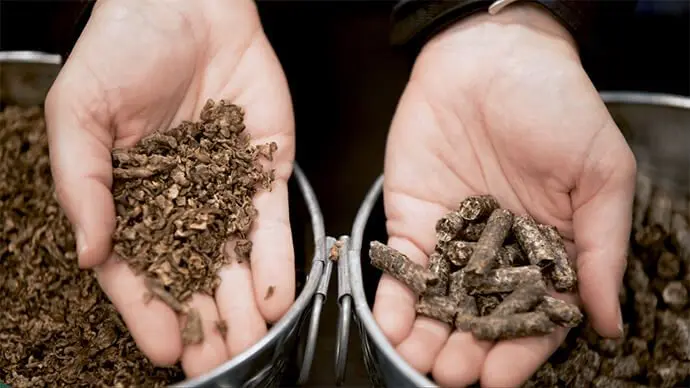
Frequently asked questions about beet pulp.
Frequently Asked Questions About Beet Pulp
You have certainly heard of owners feeding beet pulp to underweight or aging horses. You saw containers for soaking it in the utility rooms. But what is this food, and does your horse need it?
Beet pulp, a by-product of sugar beet processing, has long been used as part of a horse’s diet, but that doesn’t mean horse owners don’t have questions about it. We collected your most common questions and turned to Kelly Vineyard, MS, PhD – Equine Nutritionist at Purina Animal Nutrition and Kristen M. Janicki, MS, PAS, Equine Nutritionist from Nicholasville, Kentucky.
1. Why does a horse need beet pulp?
Beet pulp is an inexpensive, highly digestible form of fiber (significantly more digestible than or equal to hay) that offers many nutritional benefits to horses. “Bacteria in the horse’s colon can easily ferment it and use it for energy,” says Vineyard. “The energy value of beet pulp is higher than that of alfalfa granules and is close to the energy value of oats,” says Janicki, “Therefore, it is a valuable source of fiber for colon health and calories to improve body condition or fuel for work.” Vineyard claims beet pulp fiber absorbs and retains water well, and using it is an effective way to increase a horse’s intake. water .
2. What types of horses could benefit from beet pulp?
Beet pulp can be included in the diet of horses with a variety of needs. Both nutritionists say it can be used as:
- Source of fiber for horses with bad teeth. “Soaked beet pulp is good because it’s easier to chew than long-stalk hay,” says Vineyard.
- A substitute for hay when there is a shortage.
- Digestive support for horses experiencing indigestion.
- A means of improving the condition of the body. “Replacing an equal amount (by weight) of hay with beet pulp, due to the higher calorie content of the pulp, will increase the animal’s body weight,” says Vineyard.
In addition, beet pulp is a good feeding component for horses that are sensitive to excess sugar or starch (eg, insulin-resistant horses). “Beet pulp is low in sugar and starch, and has a low glycemic index,” says Vineyard, implying that beet pulp only produces a slight increase in blood glucose after a meal.
3. How do you know how much beet pulp to feed? How much pulp can I replace other foods?
The amount of bagasse you feed depends on the purpose of feeding the horse (whether you are simply adding it to the diet or completely replacing it with grain and/or forage).
Janicki notes that researchers consider it safe to replace 55% of a horse’s total diet with beet pulp – that’s equivalent to approximately 12 pounds (12*450g = 5.4 kg) of dry pulp per day for a 1,100 lb (500 kg) horse!
However, Vineyard warns: “Caution must be taken when giving more than 2-3 lbs/day, given that the overall nutritional balance of the diet may be affected by some of the compositional characteristics of the beet pulp (described in #11).”
“Regardless of the amount of pulp you feed, always pre-weigh it. Introduce beet pulp into the diet gradually,” says Janicki, “and increase the amount gradually depending on the condition of the individual horse and its desired condition.”
4. Does it matter if you feed beet pulp chips or pellets?
There are two forms of beet pulp commercially available: shavings (with or without molasses) and granulated (usually containing a small amount of molasses to help bind the grains).
Both forms are safe for horses, but shavings tend to soak up water faster than pellets (Vineyard) .
“The molasses content can be a deciding factor in choosing the shape of the pulp, especially for feeding horses requiring a low sugar diet (e.g. IR – insulin resistant) or low potassium diet (e.g. horses with hyperkalemia and intermittent paralysis),” says Janicki.
5. Can beet pulp be mixed with other foods?
“Fodder beet pulp can be treated like any other feed component,” says Vineyard. “You can feed beet pulp alone or use it along with a serving of grain, whichever makes the most sense for the particular horse and stable situation.”
Janicki says this is a reasonable solution, but most horses are happy to consume beet pulp without additives.
6. What if I try to add beet pulp to my horse’s feed and he doesn’t want to eat it?
If your horse is a picky eater, you can soak the beet pulp or mix it dry with grains or with a little oil such as corn or soybean (Janicki).
Vineyard suggests that when introducing beet pulp for the first time, do so in small quantities. You can also buy molasses and sometimes add it to the pulp for a change.
“The amount of molasses in the pulp is usually less than 5%. The molasses is used to increase the nutritional appeal of the beet pulp particles as well as to reduce the dust content,” says Vineyard. “The addition of molasses will increase the total sugar content of the beet pulp by about 2%; therefore, its addition will not lead to a significant increase in sugar intake. Adding molasses to dried beet pulp increases its nutritional appeal (important for picky horses) and helps stimulate saliva production when the horse eats it. However, if the horse has a true sensitivity to sugar/starch, choosing beet pulp without molasses is the best choice.”
7. Why do some people soak beet pulp? Is it worth it to do so?
“There is a long-standing myth that dry beet pulp before feeding should be soaked to prevent obstruction (blockage) of the esophagus,” says Janicki. “However, horses can choke on any type of feed, or on any method of feeding it, if they eat too quickly – the pulp itself will not cause the horse to choke.”
Case in point: Feed manufacturers often include beet pulp in feed mix formulations that do not require pre-soaking.
Vineyard, on the other hand, is more likely to recognize the benefit of soaking beet pulp in order to reduce the risk of esophageal blockage and improve feed intake: “While some horses tolerate dry beet pulp without complications, I always recommend soaking the beet pulp if more is added to the meal. than 1-2 pounds. The amount of water added and the length of time for it to be completely absorbed depends on several factors. For example, some horses prefer less water, while others like beet pulp. I like it liquid.”
“Add two parts cool or warm water to one part beet pulp in a bucket or large container,” suggests Janicki. “Then soak the beet pulp until it absorbs the liquid. It usually takes from 15 minutes to several hours. Remember that shavings absorb water faster than pellets.”
“The length of time for soaking will depend on the type of beet pulp, climate, stable routine, etc,” says Vineyard. “The pulp needs to soak up water long enough to become soft.”
8. How can you tell if soaked beet pulp has gone bad?
“The length of time it takes soaked beet pulp to go moldy depends on environmental conditions and the amount of water absorbed, and the best way to determine this is to smell it,” says Janicki. Throw away any moldy, fermented, or sour-smelling beet pulp.
“Soaked beet pulp can be kept in a cool environment for 12 hours or more with little risk of spoilage,” explains Vineyard. “However, spoilage can easily occur during this time in a hot/humid environment.”
9. What to do with soaked beet pulp in extremely low or high temperatures?
Soaking beet pulp can be a problem in winter when temperatures are below the freezing point of water. The first solution is not to place the beet pulp soaking container on the ground. “Usually the coldest temperatures are near the ground, and raising the container would prevent it from freezing,” says Janicki. “Also, beet pulp absorbs warm water faster than cold water, so if possible, add warm water to it to speed up the absorption and reduce the possibility of freezing,” she says.
“In the summer months, on the other hand, soak the pulp in a cool, dry place out of the reach of horses, such as a feed room. To keep the pulp from insects and rodents, find a way to cover the container, but in such a way that it maintains air circulation (for example, with a towel or insect net).”
Vineyard in extreme weather suggests feeding less beet pulp by not soaking it or by soaking just before feeding, for example by simply adding water to the beet pulp chips. “Alternatively, prepared foods can be used, which contain a high proportion of beet pulp and do not need to be soaked before feeding,” she says.
10. Are there negative aspects of beet pulp feeding? The disadvantages of feeding beet pulp, according to Janicki and Vineyard, include:
- high levels of potassium if it contains molasses (important for horses requiring a low potassium diet, suffering from e.g. hyperkalemia and periodic paralysis);
- high levels of unstructured carbohydrates if it contains molasses (important for horses requiring a low sugar/starch diet);
- increased risk of blockage of the esophagus if given dry and in large quantities;
- nutrient imbalance when feeding a large amount of pulp without a corresponding change in the rest of the diet.
11. Should beet pulp be balanced with other feeds?
While beet pulp is a valuable feed ingredient, its use as the sole feed has several disadvantages, Vineyard notes.
For example, beet pulp contains, on average, only 10% of crude protein.
“This should be taken into account when balancing diets for protein, especially for young, growing horses when certain amino acids, such as lysine, are essential for their proper growth and development,” says Janicki.
Vineyard proposes to provide additional sources of high quality protein for the rearing of young and training horses.
Further, the ratio of calcium:phosphorus in beet pulp is 10:1, with the recommended ratio being 2:1. “If the low phosphorus content of beet pulp is not compensated for, serious developmental problems can arise, especially in growing animals,” says Vineyard.
To maintain the optimal ratio, Janicki recommends combining beet pulp with grain feeds or adding an additional source of phosphorus to the diet. She also advises adding an extra source of phosphorus if you feed beet pulp along with legume hay (such as alfalfa), which has a higher calcium content than other types of hay.
Finally, Vineyard notes that beet pulp is a poor source of micronutrients and contains low levels of antioxidant vitamins A and E. general diet,” she says.
Alexandra Beckstett, The Horse Managing Editor
The author of the translation is Kuzmina V.N.





